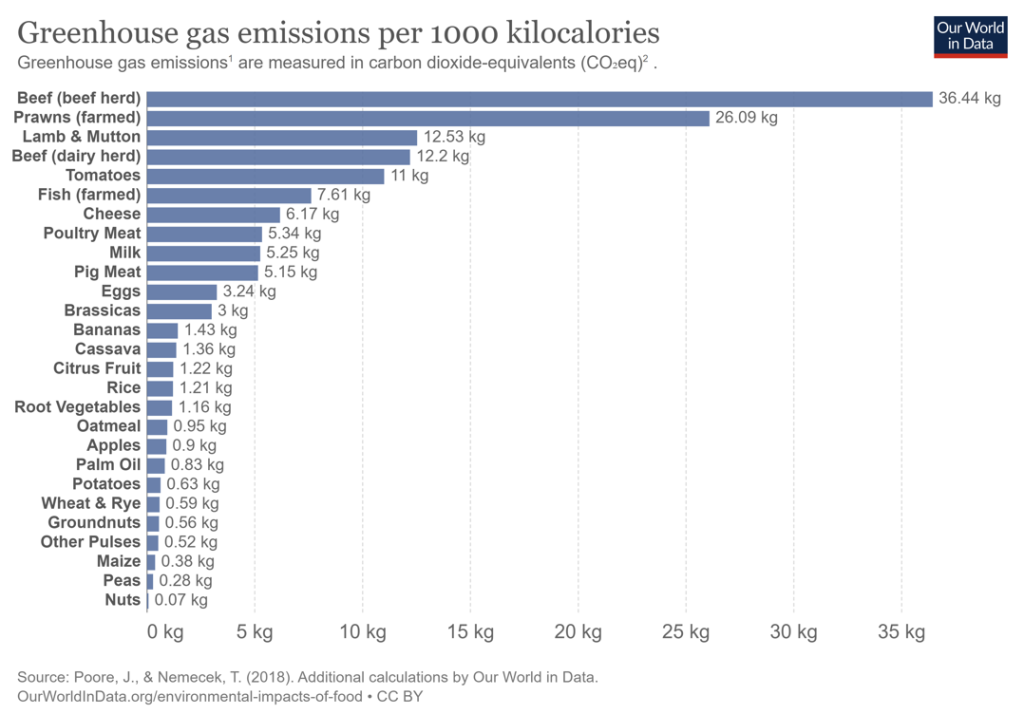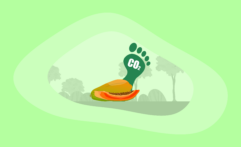What Is the Carbon Footprint of Eggplants? A Life-Cycle Analysis
Impactful Ninja is reader-supported. When you buy through links on our site, we may earn an affiliate commission.
Learn more
Learn more
.
Hey fellow impactful ninja ? You may have noticed that Impactful Ninja is all about providing helpful information to make a positive impact on the world and society. And that we love to link back to where we found all the information for each of our posts. Most of these links are informational-based for you to check out their primary sources with one click. But some of these links are so-called "affiliate links" to products that we recommend. First and foremost, because we believe that they add value to you. For example, when we wrote a post about the environmental impact of long showers, we came across an EPA recommendation to use WaterSense showerheads. So we linked to where you can find them. Or, for many of our posts, we also link to our favorite books on that topic so that you can get a much more holistic overview than one single blog post could provide. And when there is an affiliate program for these products, we sign up for it. For example, as Amazon Associates, we earn from qualifying purchases. First, and most importantly, we still only recommend products that we believe add value for you. When you buy something through one of our affiliate links, we may earn a small commission - but at no additional costs to you. And when you buy something through a link that is not an affiliate link, we won’t receive any commission but we’ll still be happy to have helped you. When we find products that we believe add value to you and the seller has an affiliate program, we sign up for it. When you buy something through one of our affiliate links, we may earn a small commission (at no extra costs to you). And at this point in time, all money is reinvested in sharing the most helpful content with you. This includes all operating costs for running this site and the content creation itself. You may have noticed by the way Impactful Ninja is operated that money is not the driving factor behind it. It is a passion project of mine and I love to share helpful information with you to make a positive impact on the world and society. However, it's a project in that I invest a lot of time and also quite some money. Eventually, my dream is to one day turn this passion project into my full-time job and provide even more helpful information. But that's still a long time to go. Stay impactful,Affiliate Disclosure
Why do we add these product links?
What do these affiliate links mean for you?
What do these affiliate links mean for us?
What does this mean for me personally?
![]()
Known as the ‘King of Vegetables’ in India, or the ‘crazy apple’ in Renaissance Italy, the eggplant can be found in food from around the world. From moussaka, to ratatouille, to brinjal bhaji, this vegetable is nutrient-dense, and high in antioxidants. Yet, much less is shared about the environmental impact, and especially the carbon emissions of eggplants. So we had to ask: What is the carbon footprint of eggplants?
Eggplant has a low carbon footprint of 0.07 kg (0.16 lbs) CO2e per pound of produce. This vegetable is land and water efficient, and is locally grown across many states. Furthermore, eggplant is rarely sold in plastic or processed. Therefore, the few resources that eggplant needs makes it a low-carbon vegetable.
In this article, we’ll walk you through the overall carbon emissions of the life-cycle of eggplants. From growing and packaging, to transportation and end-of-life practices, you will learn how this vegetable affects the planet and discover some ways to reduce and offset the footprint.
Here’s How We Assessed the Carbon Footprint of Eggplants
The carbon footprint is one of the ways we measure the effects of our human-induced global climate change. It primarily focuses on the greenhouse gas (GHG) emissions associated with consumption, but also includes other emissions such as methane (CH4), nitrous oxide, and chlorofluorocarbons, and is generally expressed in carbon dioxide equivalents (CO2e).
“Carbon footprint: the amount of greenhouse gases and specifically carbon dioxide emitted by something (such as a person’s activities or a product’s manufacture and transport) during a given period”
Merriam Webster
Basically, it is the amount of carbon emitted by you as an individual or an organization providing you with goods and services – including eggplants:
- This includes GHG emissions from producing the products that we use and foods that we eat (e.g., power plants, factories or farms, and landfills)
- GHG emissions from fuel that we burn directly or indirectly (e.g., logistics and transportation, cooling or heating facilities),
- as well as the GHG emissions attributed to how we consume these products and foods.
To understand the carbon footprint of eggplants, we must assess its life-cycle and each stage’s sustainability. This life-cycle assessment (LCA) is a method to evaluate the environmental impacts of products and materials.
Here’s the Overall Carbon Footprint of Eggplants
The overall carbon footprint of eggplants is 0.07 kg (0.16 lbs) of CO2e per pound of produce, which is very low for crops. Eggplants have a similar carbon footprint to cabbage. They have a much lower carbon footprint than salad vegetables such as salad mix, tomato, cucumber, and bell pepper.
When tucking into your favorite eggplant dish, it is important to know the carbon footprint associated with this vegetable. Then, you can make sustainable choices when it comes to your food.
| The carbon footprint of eggplants | 0.07 kg (0.16 lbs) of CO2e per pound of eggplants |
So, let’s have a look at each stage of the LCA of eggplants!
| The life-cycle stages of eggplants | Each stage’s carbon footprint |
| Growing of eggplants | The carbon footprint of growing eggplants is less than 0.05 kg (0.1 lbs) of CO2e per pound of produce, which makes up 49.75% of the overall carbon footprint of this plant. These carbon emissions are produced by the resources required to grow this crop, including pesticides, water, and land. Eggplants use a modest amount of these resources, making the carbon footprint low. |
| Harvesting, processing, and packaging of eggplants | The carbon footprint of harvesting, processing, and packaging eggplants is less than 0.05 kg (0.1 lbs) of CO2e per pound of produce, which makes up 40.20% of the overall carbon footprint of this plant. This low amount is because eggplants are rarely processed or sold in plastic packaging. |
| Transporting of eggplants | The carbon footprint of transporting eggplants is less than 0.05 kg (0.1 lbs) of CO2e per pound of produce, which makes up 10.04% of the overall carbon footprint of this plant. The leading states that produce eggplants are New Jersey, California, Florida, and Georgia, meaning that produce can be more localized, leading to a lower carbon footprint. However, the US also imports a lot of eggplants from other countries such as Canada, Mexico, and Honduras. |
| End-of-life of eggplants | The carbon footprint of the end-of-life of eggplants is largely impacted by the amount of food wasted. Eggplants are one of the least wasted vegetables, making up only 0.2% of all avoidable vegetable waste, with 2,000 tons wasted every year. Eggplants are also rarely packaged in plastic, meaning that there is little packaging waste as well. |
These four stages can be broken down in more detail to understand the factors which impact the carbon footprint of eggplants.
What Is the Carbon Footprint of Growing Eggplants
The carbon footprint of growing eggplants is less than 0.05 kg (0.1 lbs) of CO2e per pound of produce, which makes up 49.75% of the overall carbon footprint of this plant. These carbon emissions are produced by the resources required to grow this crop, including pesticides, water, and land. Eggplants use a modest amount of these resources, making the carbon footprint low.
Growing eggplants has a relatively low carbon footprint in comparison to other crops. This is because they have economic land usage and do not require an excess of water to grow.
Which factors impact the carbon footprint of growing eggplants?
- How do eggplants grow: Eggplants grow above-ground in rows, and are looped around wooden stakes to support the rather tall plant. They can also be grown in greenhouses. Large, industrial greenhouses produce carbon emissions due to their use of artificial lighting, heat, and carbon dioxide gas . This could be problematic for the overall footprint of eggplants. However, most large-scale greenhouses aim to use recycled waste heat, and use low-energy lighting, to reduce the climate impact.
- What is the growth duration of eggplants: Eggplants thrive best when transplanted, as opposed to being grown straight from seed, because this vegetable prefers warm soil conditions. Seedlings grow for 8-10 weeks before being transplanted. Around 65-90 days after transplanting, they can be harvested. In general, fewer resources have to be used on crops with short growth durations. Eggplants have a relatively long growing period, which negatively impacts the carbon footprint.
- What is the land usage of eggplants: Around 12-15 eggplants can be harvested per plant. A good yield is 25-40 tons per hectare. This makes eggplants a relatively high-yield vegetable. The consequence of using a lot of resources for a small yield, means that comparatively low-yield plants are more carbon-intensive than crops like eggplant.
- What is the water usage of eggplants: Eggplants need about 1 inch of water per week. Eggplants are fairly drought-tolerant and should not be over-watered. The amount of water used has a far smaller carbon footprint than the water requirements of other crops, like bell peppers, and tomatoes.
- What is the pesticide and fertilizer usage of eggplants: An Environmental Working Group study looking at pesticide use in crops ranked eggplant 24th in a list of 46, meaning that it has a moderate use of pesticides compared to other vegetables. Pesticides increase the carbon footprint of a crop because they produce carbon emissions through manufacturing, transportation, and application to crops.
In short, eggplants have a relatively low agricultural carbon footprint, due to the high yield and small water footprint of this crop.
What Is the Carbon Footprint of Harvesting, Processing, and Packaging Eggplants
The carbon footprint of harvesting, processing, and packaging eggplants is less than 0.05 kg (0.1 lbs) of CO2e per pound of produce, which makes up 40.20% of the overall carbon footprint of this plant. This low amount is because eggplants are rarely processed or sold in plastic packaging.
Carbon emissions are often created from machine-harvesting, intensive processing, and plastic packaging. However, eggplant is often sold whole, without packaging, and is harvested by hand. This leads to a low carbon footprint.
Which factors impact the carbon footprint of harvesting, processing, and packaging eggplants?
- How are eggplants harvested: Eggplants bruise easily, so they are harvested by hand. The stems are cut with a knife and then packaged into crates. This reduces the need for combine harvesters, which are thought to be damaging up to a fifth of the global agricultural land. Also, these machines have negative impacts on soil health and release a lot of carbon emissions. Not harvesting eggplant by machine is more labor-intensive, but creates fewer carbon emissions.
- How are eggplants processed: Around 98% of eggplants are produced for the fresh market, meaning that only 2% are processed. This could be for frozen eggplant dishes, like eggplant parmigiana, or dips like baba ganoush. Processing has a large impact on the carbon footprint of a crop, due to the machines and processing plants needed, which require vast amounts of energy and release carbon emissions. Since only 2% of eggplants are processed, the carbon footprint remains low. In comparison, 99% of corn is processed, which is why it has a higher carbon footprint.
- How are eggplants packaged: Eggplants are often sold without harmful packaging that is difficult to recycle. They are generally wrapped in paper, and shipped in wooden or fibreboard boxes. This reduces the need for plastic packaging, and is a much more carbon efficient way to package crops. Therefore, eggplant has a low carbon footprint at this stage.
In short, the lack of processing, machine harvesting, and plastic packaging used for eggplants, mean that few carbon emissions are created. This makes eggplant a sustainable choice in terms of their carbon footprint at this stage.
What Is the Carbon Footprint of Transporting of Eggplants
The carbon footprint of transporting eggplants is less than 0.05 kg (0.1 lbs) of CO2e per pound of produce, which makes up 10.04% of the overall carbon footprint of this plant. The leading states that produce eggplants are New Jersey, California, Florida, and Georgia, meaning that produce can be more localized, leading to a lower carbon footprint. However, the US also imports a lot of eggplants from other countries such as Canada, Mexico, and Honduras.
Imports of eggplant increase the carbon footprint due to more food miles. Therefore, purchasing locally grown eggplant is a way to reduce your personal carbon footprint.
Which factors impact the carbon footprint of transporting eggplants?
- Where are eggplants grown: Eggplants are a specialty crop grown throughout the United States, but less than 7,000 acres are used for eggplant production per year. New Jersey grows the majority of eggplants in the US, using 879 acres in 2019. They produce 66% of the world’s eggplants. Other leading states are California, Florida and Georgia. However, the US is the second largest global importer of eggplants, just behind Germany. Imports are mainly from Mexico, Honduras, and Canada. Because of this, the carbon footprint of eggplant is increased due to the food miles and carbon-intensive methods of transportation.
- How are eggplants transported: Like the majority of fresh produce, eggplants are transported in refrigerated vehicles. These vehicles can emit up to 29 times more potentially carcinogenic particulate matter and six times more nitrogen oxides than far larger, modern diesel truck engines. If eggplants are purchased from local farms, the carbon footprint is decreased.
In short, as the US is the second largest importer of eggplant worldwide, a lot of the produce purchased may have a higher carbon footprint. To avoid this, try to find eggplant grown locally.
What Is the Carbon Footprint of the End-of-Life of Eggplants
The carbon footprint of the end-of-life of eggplants is largely impacted by the amount of food wasted. Eggplants are one of the least wasted vegetables, making up only 0.2% of all avoidable vegetable waste, with 2,000 tons wasted every year. Eggplants are also rarely packaged in plastic, meaning that there is little packaging waste as well.
Fresh eggplant has a long shelf life, lasting 2-3 weeks in the refrigerator, or up to a year if frozen. This long shelf life means that eggplant is not as frequently wasted as vegetables such as salad mix or lettuce. Eggplants are also compostable, but can end up in landfill. In addition, if packaged in plastic, the packaging is usually recyclable, but can also end up in landfill if not disposed of properly.
Which factors impact the carbon footprint of the end-of-life of eggplants?
- How are eggplants disposed of: 2,000 tons of avoidable eggplant waste is discarded every year. It is compostable, however, food waste in landfill is a big problem for the environment. 16% of all food is wasted on farms, largely for aesthetic reasons. The resources used to grow these crops just to discard them are enormous, and negatively impact the carbon footprint of this crop.
- How is the packaging of eggplants disposed of: Plastic packaging can increase the carbon footprint of a crop, due to the carbon-intensive resources needed to make the plastic. A lot of plastic that we recycle ends up on the other side of the world, causing a threat to developing countries. So, it is not as good for the environment as we may imagine. When eggplant is sold in plastic packaging, this increases the carbon footprint. However, generally, this vegetable is sold loose which is good news for the overall carbon footprint of this crop.
In short, eggplant is not often wasted, but when it is, be sure to compost it rather than throwing it in the trash. Also, avoid eggplant packaged in plastic, and opt for loose produce to reduce waste.
How Does the Carbon Footprint of Eggplants Compare to Other Types of Food
Eggplant has a very low carbon footprint compared to other vegetables. As well as this, vegetables tend to produce far fewer carbon emissions than other types of food.
Let’s see how eggplant compares with other vegetables.
How Does the Carbon Footprint of Eggplants Compare to Other Types of Vegetables
In comparison to other vegetables, the carbon footprint of eggplants is very low. For example, cucumbers produce over fourteen times the carbon emissions of eggplants. Eggplants have the same carbon footprint as low-carbon cabbage.
So, eggplants have a low carbon footprint in comparison with other vegetables. But how do they compare to other types of food?
How Does the Carbon Footprint of Eggplants Compare to Other Types of Food in General
Eggplants are one of the most sustainable options in comparison to other types of food. They produce nearly 58 times less greenhouse gas emissions than beef.
When it comes to greenhouse gas emissions (GHG), foods are often compared in terms of emissions per 1,000 kilocalories (as opposed to their weight in lbs or kg).

Potatoes and eggplants have a similar carbon footprint. Looking at the chart above shows how low the carbon emissions of these crops are in comparison to animal-based produce.
Additionally, since eggplant is low in calories, a far greater amount of produce is needed to equal 1,000 kilocalories.
- To eat 1,000 kilocalories, you would need to consume over 40 servings, or over 6.6 full eggplants, or around 141 ounces.
- In comparison to beef you would only need 4.6 servings to eat 1,000 kilocalories, or 16 ounces.
- Comparatively, salad vegetables have an extremely high carbon footprint per kilocalorie, but are enormously less calorific than animal-based food.
- More calorific plant-based foods, such as pulses and nuts, have a miniscule carbon footprint in comparison to animal-based proteins. A single portion of beef has nearly nine times the calories of a portion of eggplant.
- This means that per portion, you will be consuming fewer calories, and so the carbon footprint will not be as large as this graph suggests.
Even though the carbon emissions for eggplants are very low in comparison to other types of food, try to be mindful of the ways you can lessen your environmental impact when you purchase them.
How Can You Reduce and Offset Your Personal Carbon Footprint
All of the food you eat will have some form of carbon footprint, even when you buy foods with low CO2e, such as eggplants. However, there are ways to offset and reduce your personal carbon footprint.
There are a few easy techniques to buy more eco-friendly eggplants, and you can also find ways to offset the carbon footprint after your purchase.
How Can You Reduce Your Carbon Footprint When Shopping for Eggplants
When shopping for eggplants, consider these ways to lessen your impact on the environment.
- Shop locally and seasonally: Eggplants are usually in season from July to October, depending on the state where they are grown. Buying from local farms reduces the carbon emissions produced and makes eggplant a much more sustainable choice.
- Choose organic: Organic eggplants produce a much lower carbon footprint than non-organic vegetables, due to the lack of pesticide production, distribution, and the overall higher health of soil for crops, insects, and animals.
- Avoid plastic waste: Avoid eggplant packaged in plastic, as it is a vegetable which does not need packaging to extend its shelf life. Reducing plastic waste is an easy way to choose a lower-carbon option.
Taking these actions are a great way to lessen your own carbon footprint, but there are also ways to offset the impact of consuming eggplants as well.
How Can You Offset Your Personal Carbon Footprint
Carbon offsets are reductions in carbon emissions that are used to compensate for carbon emissions occurring elsewhere – for example for the carbon emissions that are associated with eggplants. They are measured in tons of CO2 equivalents and are bought and sold through international brokers, online retailers, and trading platforms on what is known as the global carbon offset market.
“Carbon Offset: a way for a company or person to reduce the level of carbon dioxide for which they are responsible by paying money to a company that works to reduce the total amount produced in the world, for example by planting trees”
Oxford Dictionary
In terms of eggplants – and indeed all food types – there will always be a carbon footprint, because of the resources it takes to get your food from farms to the place where you’ll eventually eat them. And while there are ways to reduce your carbon footprint when shopping for eggplants, carbon offsets would be a way to reduce your CO2e emissions all the way down to net zero (or even to become climate positive).
However, when you purchase carbon offsets, it’s important that they actually make a difference in offsetting (aka reducing) total carbon emissions. To achieve that, the following are key criteria:
- Carbon offset projects have to be effective (different projects have different effectiveness rates)
- Carbon offset projects have to be additional
- Carbon offset projects have to be permanent
- The claims from carbon offset projects have to be verifiable
To find the best carbon offsets for you personally, check out our full guide on the best carbon offsets for individuals, where you’ll also learn more about how these carbon offset projects work, what their respective offsetting costs are, and what your best way would be to offset your own carbon emissions.
Final Thoughts
Eggplants have a very low carbon footprint in comparison to other vegetables, and other food in general. However, you can still try to reduce your carbon footprint further by eating organic, reducing food waste, and purchasing local, seasonal produce. When you do enjoy eggplant, think about whether you can offset the carbon emissions created, to make this healthy snack an even more sustainable option!
Stay impactful,

Sources
- Indiana Public Media: Eight Fascinating Facts About Eggplant
- Minimalist Baker: The BEST Vegan Moussaka
- Jamie Oliver: Classic Ratatouille
- Vegan Punks: Brinjal Bhaji in 45 Minutes
- Healthline: 7 Surprising Health Benefits of Eggplants
- Britannica: Carbon footprint
- Science Direct: Life-cycle assessment (LCA)
- MIT SMR: Strategic Sustainability Uses of Life-Cycle Analysis
- Carbon Cloud: Eggplant
- Impactful Ninja: What Is the Carbon Footprint of Cabbage
- Impactful Ninja: What Is the Carbon Footprint of Salad Mix
- Impactful Ninja: What Is the Carbon Footprint of Tomatoes
- Impactful Ninja: What Is the Carbon Footprint of Cucumber
- Impactful Ninja: What Is the Carbon Footprint of Bell Peppers
- WRAP: The Food We Waste
- University of Missouri: Eggplant Production
- Vegetable Growers News: Research: Specialty eggplant varieties grow well in high tunnels
- Environment Blog: Are greenhouses good or bad for the environment?
- Bonnie Plants: How to Grow and Plant Eggplant
- Agraryo: Eggplant Farming: How to Plant and Grow Eggplant for Profit
- Harvest to Table: How to Plant and Grow Eggplant
- Environmental Working Group: Full List
- BBC News: Farm machinery exacting heavy toll on soil – study
- Farms Wise: Are Tractors Bad for the Environment?
- Agricultural Marketing Resource Centre: Eggplant
- Impactful Ninja: What Is the Carbon Footprint of Corn
- Truckload Shipping: How are Eggplants Transported?
- Hortidaily: New Jersey grows the most eggplants in the world
- OEC: Aubergines(egg-plants), fresh or chilled
- Fresh Fruit Portal: US to Potentially Import Eggplant from Morocco
- The ACR Journal: Refrigerated vehicles contribute to thousands of deaths and costs across EU
- Impactful Ninja: What Is the Carbon Footprint of Lettuce
- World Wildlife Fund: Fight climate change by preventing food waste
- World Wildlife Fund: What farmers found when they measured fresh produce left in the field
- Let’s Recycle: Supermarkets to take back plastic film in-store
- Sesotec: Recycling more packaging –potential for PE and PP
- Live Science: The Plastic We ‘Recycle’ Is Actually Horrible for the Environment
- Impactful Ninja: What Is the Carbon Footprint of Asparagus
- Impactful Ninja: What Is the Carbon Footprint of Spinach
- Impactful Ninja: What Is the Carbon Footprint of Cauliflower
- Impactful Ninja: What Is the Carbon Footprint of Broccoli
- Impactful Ninja: What Is the Carbon Footprint of Celery
- Impactful Ninja: What Is the Carbon Footprint of Kale
- Impactful Ninja: What Is the Carbon Footprint of Carrots
- Impactful Ninja: What Is the Carbon Footprint of Potatoes
- Impactful Ninja: What Is the Carbon Footprint of Mushrooms
- Impactful Ninja: What Is the Carbon Footprint of Onions
- Our World in Data: Greenhouse Gas Emissions per 1,000 kilocalories
- WebMD: Health Benefits of Eggplant
- Healthline: Beef 101: Nutrition Facts and Health Effects
- Food Network: In Season: Eggplant
- Columbia Climate School: Is Organic Food Really Better for the Environment?
- Impactful Ninja: 12 Best Carbon Offsets for Individuals




